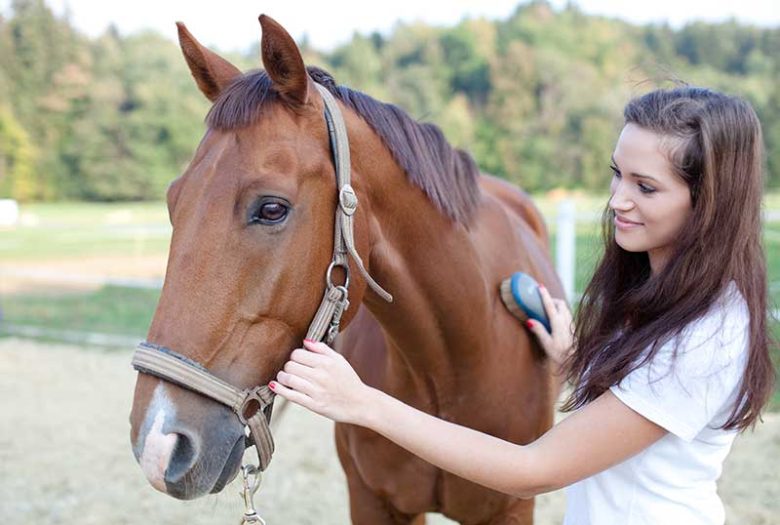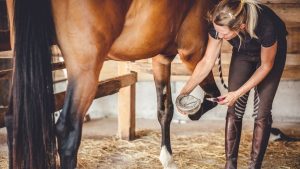Keeping your horse’s coat healthy and shiny is not just about appearance; This indicates that he or she is generally healthy and happy. The key to a shiny coat is to feed your pet the right food, clean it regularly, and give it lots of love. This article covers the most important parts of caring for your horse’s coat and gives you proven advice on how to keep your horse not only looking great but feeling great too.
Introduction to Horse Coat Care
You can tell the health of a horse from its coat. A shiny, smooth coat means the animal is well-fed and cared for and lives in a healthy environment. On the other hand, dull, brittle coats could mean that the animal is not getting enough food, is sick, or is not receiving enough care. To ensure that the outside of your horse’s coat is as healthy as the inside, you must first learn the basics of coat care.
Understanding the Horse’s Skin and Coat
Horses have thousands of hair cells, oils, and sweat glands in their coat. They work together to keep the horse warm and protected from the elements. Outerwear changes enormously with the seasons. In winter, horses grow a thicker coat to keep them warm, and in spring they shed their coat to stay cool. To properly care for your coat, you need to understand these normal cycles.
Give your dog the right nutrition to keep his coat shiny
What your horse eats is very important for maintaining a healthy coat. Vitamins, minerals, and essential fatty acids all help keep hair looking great and staying strong. A healthy diet rich in omega-3 fatty acids, zinc, and biotin can keep your pet’s coat looking great and maintain its overall health.
The Basics of Grooming for Optimal Coat Health
Grooming your dog regularly will not only keep his coat clean but will also increase blood flow, which promotes healthy hair growth. Daily brushing, combing, and paying special attention to the mane and tail keep the coat in good condition. Choosing the right tools and learning to use them correctly are important parts of cleaning.
Bathing Your Horse: Dos and Don’ts
Bathing your pet regularly will keep the coat clean, but washing your pet too often can strip your pet’s natural oils, leading to dryness and irritation. It’s important to know how to keep your horse clean while protecting its natural oils. Using a shampoo and conditioner that is suitable for your horse’s skin type can also help prevent problems and make the coat shinier.
More advanced modification methods
For those who just want to do more than just basic grooming, cutting their hair and using hair strengtheners can be helpful. But it’s important to understand how these actions can damage your skin and clothing to keep them safe.
Protect the coat against external forces
The jacket can be damaged by environmental factors, such as sunlight, rain, and mud. Taking protective measures, such as using sunscreen specifically for horses and limiting the time your horse is in wet conditions, can help keep your horse’s coat healthy.
Solve common coat problems
Common hair problems, such as fungal diseases, parasites, and skin diseases, require immediate attention. Catching symptoms early and getting the right treatment can prevent minor problems from getting worse.
Care for Coat in the different seasons
To keep your coat healthy all year round, make sure your coat care routine changes with the seasons. Each season brings different care challenges and opportunities, from losing support in the spring to managing moisture in the winter.
Healthy ways to care for Coat
Natural and holistic techniques can be used in addition to traditional coat care methods to further improve the health of your horse’s skin and coat. Flaxseed, which contains omega-3 fatty acids, and soothing chamomile are two herbal supplements that can improve the health and shine of your pet’s hair and skin from the inside out. Managing stress through regular exercise and a stable environment can also help with coat health, as stress can dull the coat and lead to hair loss.
New aids and products for horse coat care
The market is always changing, and new tools and merchandise are making coat care easier and better. These new products, like natural, eco-friendly shampoos and high-tech grooming brushes that massage and stimulate the skin, can give you new ideas on how to care for your horse’s hair. If you want to DIY, you can make a horse conditioner from natural oils based on your horse’s needs.
Conclusion
All in all, caring for your horse’s coat requires a whole-animal approach, including good nutrition, regular grooming, and attention to your horse’s living space. By understanding what your horse’s coat needs and using the tips we’ve discussed, you can ensure that your horse not only looks great but is also healthy and happy. Remember, the care and attention you give it every day are just as important as the items you use to keep your coat shiny.
FAQs
1. Why does a horse’s coat look dull?
Poor diet, inadequate grooming, health issues, or stress are just a few causes of dull hair. Ensuring your pet has a healthy diet, regular grooming, and a stress-free space can help restore the luster of their hair.
2. How often should I wash my horse?
How often you bathe your horse depends on how active it is, where it lives, and its skin type. Generally speaking, bathing should only be done when necessary to avoid stripping the coat of its natural oils. Partial cleaning should be used during normal maintenance.
3. How do I make my horse’s coat look better?
Yes, supplements rich in minerals, vitamins, and important fatty acids can help your horse’s coat look and feel better. Taking omega-3 supplements, biotin, and zinc can help your health.
4. Do I need to trim my horse’s coat?
Shearing is usually done on high-performance horses or horses that get a lot of work during the cooler months to prevent them from getting too hot and to keep their appearance neat. Whether or not to trim depends on how much work your horse does and your personal preference.
5. How do I prevent sun damage to my horse’s coat?
You can protect your horse from UV rays by applying sunscreen designed for horses to uncovered areas, such as the nose and around the eyes. It’s also a good idea to provide shade and use mosquito repellents that block UV rays.
6. What’s the best way to deal with losses during certain times of the year?
During hair loss season, improving your cleansing habits can help you cope with hair loss and encourage new growth. Shedding blades or curry combs are great tools for removing loose hair, and regular brushing of your dog’s coat will keep it healthy.



